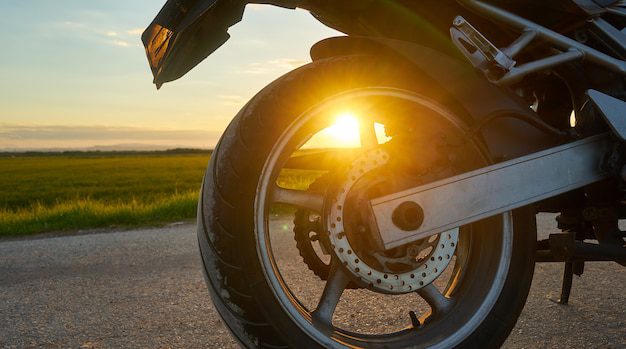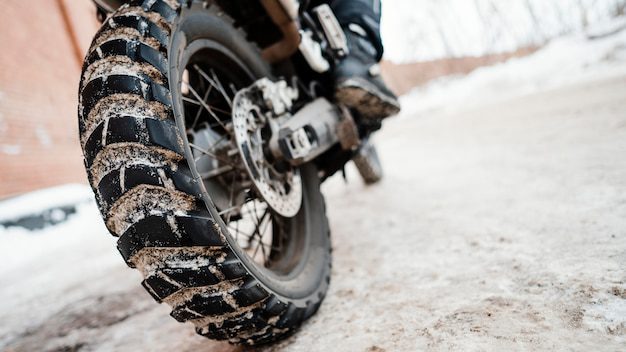How many years does a motorcycle TYRE last?
A motorcycle tyre’s lifespan is influenced by various factors, including the type of tyre, riding conditions, maintenance, and the rider’s style. On average, a motorcycle tyre can last anywhere from 5 to 10 years. However, it is important to note that this estimate may vary depending on individual circumstances.
Factors affecting the lifespan of a motorcycle tyre
Several factors contribute to the lifespan of a motorcycle tyre. These include:
- Type of Tyre: Different types of tyres have varying durability. For instance, sport and performance-oriented tyres tend to have a shorter lifespan compared to touring or cruiser tyres.
- Riding Conditions: The quality of roads and the weather conditions you ride in can impact the wear and tear on your tyres. Rough roads, extreme temperatures, and wet conditions can accelerate tyre degradation.
- Maintenance: Regular maintenance, such as proper tire pressure, adequate tread depth, and routine inspections, can extend the life of your motorcycle tyre. Neglecting maintenance tasks can lead to premature wear and reduced lifespan.
- Riding Style: Aggressive riding, frequent hard braking, and sharp cornering can put more stress on your tyres, potentially shortening their lifespan.
Recognizing signs of tyre wear and replacement
It is crucial to regularly inspect your motorcycle tyres for signs of wear and replace them when necessary. Some common indicators that your tyre may need replacing include:
- Tread Depth: If the tread depth reaches the wear bars or falls below the recommended minimum, it’s time for a new tyre.
- Cracks and Bulges: Inspect the sidewalls for any cracks, bulges, or other irregularities. These can indicate structural damage, and the tyre should be replaced immediately.
- Aging: Even if your tyre appears to have sufficient tread, if it is over five years old, it is recommended to replace it due to the gradual deterioration of rubber compounds over time.
“Ensuring that your motorcycle tyres are in good condition is essential for your safety and performance on the road.”
Proper care and maintenance tips for extending tyre life
To maximize the lifespan of your motorcycle tyres, consider the following tips:
- Regular Inspections: Check the tyre pressure, tread depth, and overall condition regularly.
- Proper Inflation: Maintain the recommended tyre pressure as indicated by the manufacturer.
- Rotate Tyres: Regularly rotating your tyres helps ensure even wear across all tyres.
- Storage: When storing your bike for an extended period, keep it in a cool, dry place away from direct sunlight to prevent premature ageing of the rubber.
- Choose the right tyre: Select a tyre tailored to your riding style and the conditions you frequently encounter.
By following these tips and being vigilant about regular maintenance, you can significantly extend the lifespan of your motorcycle tyre while ensuring safe and enjoyable rides.
How long does it take to break in new motorcycle tyres?
What is tyre break-in period?
The break-in period of new motorcycle tyres refers to the initial kilometers or miles needed for the tyres to reach their optimal performance. During this period, the rubber compound and tread pattern of the tyres settle in, allowing for improved grip and handling.
Factors affecting the break-in period
The time it takes to break in new motorcycle tyres can vary depending on several factors:
- Riding style: Aggressive riding may wear down the tyre surfaces faster, thereby reducing the break-in period.
- Tyre type: Different types of tyres have varying break-in periods. Sport and track-focused tyres tend to require a longer break-in compared to touring tyres.
- Road conditions: Frequent riding on rough or wet roads can help accelerate the break-in process.
Recommended break-in distance
While the exact break-in distance can vary, many manufacturers recommend riding between 100 and 200 miles (160-320 kilometers) before the tyres are fully broken in. It’s important to follow the specific recommendations provided by the tyre manufacturer, as they have the most knowledge about their products.
Tips for breaking in new motorcycle tyres
- Ride conservatively during the break-in period, gradually increasing speed and leaning angles.
- Avoid sudden acceleration, hard braking, and aggressive cornering.
- Check tyre pressures regularly and maintain them within the recommended range.
Quote from expert mechanic:
“Properly breaking in your new motorcycle tyres is crucial for ensuring their longevity and performance. Take the time to follow the manufacturer’s recommendations and ride responsibly during the break-in period.”
How do I know if my motorcycle tyres need replacing?
As a motorcycle owner, it’s crucial to stay vigilant about the condition of your tyres. Good tyre maintenance ensures not only your safety but also optimum performance and fuel efficiency. Here are some key indicators that will help you determine when it’s time to replace your motorcycle tyres:
1. Tread Depth
The tread depth is an important indicator of tyre wear and grip. In the UK, the legal minimum tread depth for motorcycle tyres is 1mm across the central three-quarters of the tyre. Use a tread depth gauge or the built-in tread wear indicators to check if your tyres have reached this limit.
2. Visible Damage
Inspect your tyres for any visible signs of damage such as cuts, bulges, or sidewall cracks. These issues can compromise the integrity of the tyre and increase the risk of a blowout. If you notice any damage, it’s advisable to replace the tyre immediately.
3. Age of the Tyres
Tyres deteriorate over time, regardless of their mileage. Rubber compounds harden and lose elasticity, which affects grip and performance. It is generally recommended to replace motorcycle tyres that are more than five years old, even if they appear to be in good condition.
4. Uneven Wear
Uneven wear patterns on your tyres can indicate alignment or suspension issues. Inspect the tread surface and look for any areas that are significantly more worn than others. If you notice uneven wear, it’s recommended to have your bike checked by a professional.
5. Handling and Performance
If you notice a decline in your bike’s handling, such as increased vibrations or reduced grip, it could be a sign that the tyres are worn out. Poor handling and decreased performance are clear indicators that you need to replace your tyres.
Remember, regular inspections and maintenance are essential to ensure your motorcycle tyres are in optimal condition.
In addition to these signs, always follow manufacturer recommendations for tyre maintenance and replacement. It’s also important to choose the right type of tyre for your motorcycle and riding style. Consult with a tyre specialist or refer to your bike’s manual for guidance.
By regularly checking your motorcycle tyres for wear and tear, you can stay safe on the road and enjoy a smoother riding experience.
How Many Miles Should a Motorcycle Tyre Last?
Introduction
Riding a motorcycle can be an exhilarating experience, but it also comes with the responsibility of properly maintaining your bike. One important aspect of motorcycle maintenance is keeping an eye on the condition of your tyres. As a biker, you might be wondering how many miles a motorcycle tyre should last.
Factors Affecting Tyre Lifespan
Several factors can influence the lifespan of a motorcycle tyre. The type of tyre you choose, your riding style, the road conditions you encounter, and proper tyre maintenance all play a role in determining how long your tyres will last.
Choosing the Right Tyre
Selecting the right tyre for your motorcycle is crucial. Different tyres are designed for different purposes, such as touring, sport riding, or off-roading. Make sure to consider the type of riding you do most often and choose a tyre that suits your needs.
Riding Style
Your riding style can significantly impact the lifespan of your motorcycle tyres. Aggressive cornering, hard braking, and rapid acceleration can cause excessive wear and tear, reducing the mileage you can get out of your tyres. Maintaining smooth and controlled riding techniques can help extend their lifespan.
Road Conditions
The road conditions you frequently encounter also affect the longevity of your motorcycle tyres. Rough or poorly maintained roads, gravel, and debris can lead to premature wear. If you frequently ride in such conditions, consider opting for tyres with better tread life or investing in tyre protection accessories.
Tyre Maintenance
Proper tyre maintenance is essential for maximizing their lifespan. Regularly inspect your tyres for signs of wear, such as uneven tread, cracking, or bulges. Check the tyre pressure regularly and ensure it is within the manufacturer’s recommended range. Keeping your tyres properly inflated and aligned can significantly increase their longevity.
Typical Tyre Lifespan
The average mileage a motorcycle tyre can last varies depending on the factors mentioned earlier. On average, most motorcycle tyres can provide anywhere from 5,000 to 20,000 miles of use. However, this can vary significantly based on the aforementioned factors and individual riding habits.
Quote: “Regular maintenance and proper riding techniques are essential for getting the most out of your motorcycle tyres.” – Motorcycle Enthusiast Magazine
Conclusion
Breaking in new motorcycle tyres is an important step in maximizing their performance and durability. By riding conservatively and gradually pushing the limits, riders can ensure that their tyres reach their full potential. Remember to always prioritize safety and consult the manufacturer’s guidelines for specific recommendations.
While there is no definitive answer to how many miles a motorcycle tyre should last, it is crucial to prioritize regular maintenance and safe riding practices to ensure their longevity. By selecting the right tyre, adopting a smooth riding style, considering road conditions, and properly maintaining your tyres, you can extend their lifespan and make the most out of your biking adventures.



